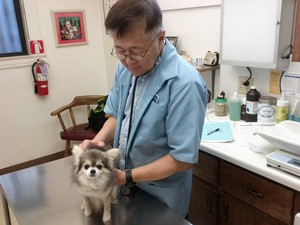Millions of pets are lost (or stolen) every year. Plus, natural disasters — like fires, floods, hurricanes and tornadoes — can easily catch you off-guard when they take place right in your own backyard. Even a car accident could send your dog scampering in a strange environment.
The truth is your dog can get away from you very quickly due to a number of different circumstances.
Since most lost dogs end up in shelters where they are either adopted or euthanized, it’s incredibly important to microchip your dog in order to prevent this from happening to your dog and to make it easier for you to be reunited with your dog should you ever become separated.
What Is Microchipping?
Microchipping is painless 2-second procedure where a veterinarian inserts a small chip about the size of a piece of rice — just beneath your dog’s skin, between the shoulder blades. It typically costs less than $50 to get your dog microchipped.
However, what many people don’t realize is that just having the microchip implanted in your dog isn’t enough.
You must also register your dog’s microchip and keep the information up-to-date so that you can be reached if your dog is found!
It’s worth noting that dog breeders and animal shelters often insert a microchip before sending pups to their new homes, however, they do not register the chip.
That’s exactly what happened with a dog that I found roaming the streets in my neighborhood recently.
I Found An Unregistered Microchipped Dog
When I found a stray dog in my front yard, I was thrilled to see that he was wearing a collar and ID tags.
One of the tags had the owner’s address (which was in another state). The other tag had a microchip ID # and a phone number to call if you found this dog.
So I called — only to learn that the owner hadn’t registered the dog associated with this microchip number.
As it turned out, the dog’s owner had just moved to town and had only lived in this neighborhood for a few weeks when the dog managed to escape from the backyard.
Not only hadn’t the owner gotten new ID tags for his dog’s collar that reflected his new address yet, but he also hadn’t ever called the microchip company to link this 2-year-old dog to his microchip.
When I called the phone number on the dog’s tag, that’s exactly what the company rep told me: “We show that a dog breeder originally microchipped this dog, but the dog’s microchip hasn’t been registered to the dog’s new owner yet. As frustrating as this is, we don’t have any way to contact the dog’s owner.”
Ugh!
My husband and I decided to walk the dog through the neighborhood, stopping everyone we passed to ask if they recognized the dog as possibly a neighbor’s. No one recognized it (because the dog’s owner was so new to the area).
Coincidentally, just as we were walking past the dog’s own house, the owner pulled up in his car — surprised to find his dog outside of his fenced-in yard.
We explained that we called all the phone numbers on the dog’s tags to no avail, and he explained that he had never registered the dog’s microchip information… but he would now!
How To Register Your Dog’s Microchip
The microchip registration process usually takes place separately — not at the vet or animal shelter’s office, but rather with the microchip company directly.
There are several different microchip companies. While the brand of your dog’s microchip is not all that important, it is important to realize that each brand has its own separate registry.
Fortunately, as microchipping is becoming more popular, standardized practices and global registries are becoming more common as well. Thanks to universal scanners that can recognize all brands of microchips, simply having your dog microchipped is much more important than the brand of your dog’s microchip. Therefore, you can also use a universal microchip registry service online:
Sometimes a small fee ($10 to $20) is charged to maintain your records and keep your current address linked to your dog’s unique microchip ID number.
It’s up to you to remember to keep your contact information up-to-date in the microchip registry each time you move. If you don’t, your dog’s microchip becomes completely useless!
Microchips Don’t Ever Have To Be Replaced
Once implanted, your dog’s microchip remains in place for the rest of his lifetime. So, it’s a life-long, permanent ID for your dog.
Plus, if your dog switches owners, it’s not necessary to get a new microchip. Instead, you simply update the microchip’s registration data.
You can quickly and easily change the contact information on your dog’s microchip at any time.
Say, for example, you find a lost dog and nobody claims him, so you have him microchipped and call him your own. But then, a few days later, the owner arrives to claim the dog. In this case, changing the contact information back to the original owner can be done.
The same is true if you decide to give your dog a new home. You can simply update the registry with the new owner’s information. From that point forward, it’s up to the new owner to keep their contact information up-to-date in the microchip registry.
How To Change Your Dog’s Microchip Information
- Use a universal dog microchip registry online — where you don’t have to know the brand of your dog’s microchip.
- Or, contact the specific manufacturer of your dog’s microchip, if you know it.
A Microchip Goes Hand In Hand With A Dog Collar And ID Tag
A pet microchip is a great backup for your dog’s typical ID tag and collar.
The fact is not every shelter and veterinarian’s office has a microchip scanner — but most do, and the numbers are steadily increasing.
Still, it’s important to make sure that your dog also wears an ID tag and collar at all times.
If your dog becomes separated from you or lost, trust me, you want to have as many things working in your favor as possible. The easier it is for people to ID your dog, the more likely your dog will be returned to you.
What To Do If Your Dog Becomes Lost
1. Notify your dog’s microchip company. Some will immediately send out an e-mail alert to animal shelters, veterinary clinics and other members of their network that are within a 25-mile radius of where your pet was lost. They may also have a Lost Pet Poster service and other benefits available to you.
2. Contact your vet and the local animal shelter to let them know and be on the watch for a dog matching your dog’s description.
3. Scour the neighborhood and start looking for your dog. Make a photocopy of a picture of your dog and hang posters at major intersections, on community bulletin boards at local stores, even on your car!
4. Post info about your dog and check pet lost & found boards online like PetFinder and 24PetWatch.






